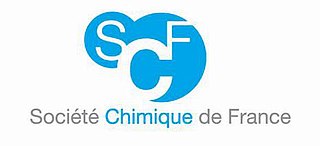
Antoine-Laurent de Lavoisier, also Antoine Lavoisier after the French Revolution, was a French nobleman and chemist who was central to the 18th-century chemical revolution and who had a large influence on both the history of chemistry and the history of biology.

Kevlar (para-aramid) is a strong, heat-resistant synthetic fiber, related to other aramids such as Nomex and Technora. Developed by Stephanie Kwolek at DuPont in 1965, the high-strength material was first used commercially in the early 1970s as a replacement for steel in racing tires. It is typically spun into ropes or fabric sheets that can be used as such, or as an ingredient in composite material components.
The Lemelson–MIT Program awards several prizes yearly to inventors in the United States. The largest is the Lemelson–MIT Prize which was endowed in 1994 by Jerome H. Lemelson, funded by the Lemelson Foundation, and is administered through the School of Engineering at the Massachusetts Institute of Technology. The winner receives $500,000, making it the largest cash prize for invention in the U.S.

Stephanie Louise Kwolek was a Polish-American chemist who is known for inventing Kevlar. Her career at the DuPont company spanned more than 40 years. She discovered the first of a family of synthetic fibers of exceptional strength and stiffness: poly-paraphenylene terephthalamide.

Charles John Pedersen was an American organic chemist best known for describing methods of synthesizing crown ethers during his entire 42-year career as a chemist for DuPont at DuPont Experimental Station in Wilmington, Delaware, and at DuPont's Jackson Laboratory in Deepwater, New Jersey. Often associated with Reed McNeil Izatt, Pedersen also shared the Nobel Prize in Chemistry in 1987 with Donald J. Cram and Jean-Marie Lehn. He is the only Nobel Prize laureate born in Korea other than Peace Prize laureate Kim Dae-jung.

The National Medal of Technology and Innovation is an honor granted by the President of the United States to American inventors and innovators who have made significant contributions to the development of new and important technology. The award may be granted to a specific person, to a group of people or to an entire organization or corporation. It is the highest honor the United States can confer to a US citizen for achievements related to technological progress.

The Perkin Medal is an award given annually by the Society of Chemical Industry to a scientist residing in America for an "innovation in applied chemistry resulting in outstanding commercial development." It is considered the highest honor given in the US chemical industry.

Anders Hallberg is a Swedish pharmaceutical researcher, professor in medicinal chemistry and 2006-2011 Rector Magnificus and Vice Chancellor at Uppsala University.

Joseph Clois Shivers Jr. was an American textile chemist who was based in West Chester, Pennsylvania, best known for his role in the structural development of Spandex, a thermoplastic elastomer, in the 1950s, while employed at DuPont.

Owen Wright Webster was a distinguished member of the organic and polymer chemistry communities. His polymerization technique for making block copolymer dispersing agents is used by DuPont to make ink-jet printer inks.
Charles Milton Altland Stine was a chemist and a vice-president of DuPont who created the laboratory from which nylon and other significant inventions were made. He was also a devout Christian who authored a book about religion and science.

The Geochemical Society is a nonprofit scientific organization founded to encourage the application of chemistry to solve problems involving geology and cosmology. The society promotes understanding of geochemistry through the annual Goldschmidt Conference, publication of a peer-reviewed journal and electronic newsletter, awards programs recognizing significant accomplishments in the field, and student development programs. The society's offices are located on the campus of the Carnegie Institution for Science in Washington, DC.

The Société Chimique de France (SCF) is a learned society and professional association founded in 1857 to represent the interests of French chemists in a variety of ways in local, national and international contexts. Until 2009 the organization was known as the Société Française de Chimie.
Thomas H. Chilton was a chemical engineer and professor. He is considered a founder of modern chemical engineering practice and lectured widely around the world. He received numerous awards, including an honorary doctorate and the President's Certificate of Merit. In 1994, DuPont named a laboratory in Wilmington, Delaware for him.

The Charles Goodyear Medal is the highest honor conferred by the American Chemical Society, Rubber Division. Established in 1941, the award is named after Charles Goodyear, the discoverer of vulcanization, and consists of a gold medal, a framed certificate and prize money. The medal honors individuals for "outstanding invention, innovation, or development which has resulted in a significant change or contribution to the nature of the rubber industry". Awardees give a lecture at an ACS Rubber Division meeting, and publish a review of their work in the society's scientific journal Rubber Chemistry and Technology.
William Charles Drinkard, Jr. was an American industrial chemist and the inventor of the catalytic hydrocyanation process for making adiponitrile, a key intermediate in nylon production.

Herbert S. Eleuterio was an American industrial chemist noted for technical contributions to catalysis, polymerization, industrial research management, and science education. In particular, he discovered the olefin metathesis reaction and several novel fluoropolymers. Additionally, he explored techniques for research leadership, especially methods for fostering collaboration, globalization, and scientific creativity.
Peter Trefonas is a retired DuPont Fellow at DuPont, where he had worked on the development of electronic materials. He is known for innovations in the chemistry of photolithography, particularly the development of anti-reflective coatings and polymer photoresists that are used to create circuitry for computer chips. This work has supported the patterning of smaller features during the lithographic process, increasing miniaturization and microprocessor speed.